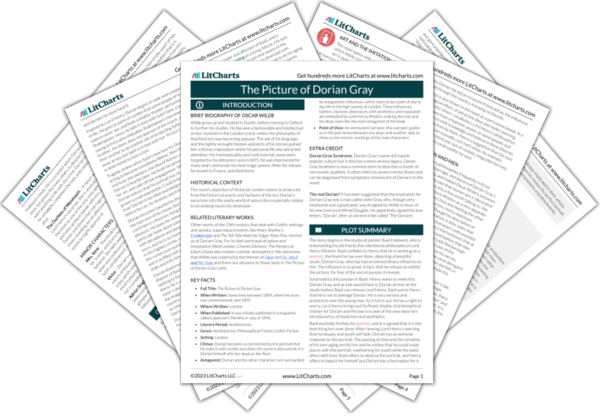Summary
Analysis
Dorian is woken by his valet well into the afternoon. He rises and catches up on his regular routine, opening invitations to parties and having a leisurely breakfast in his beautiful library. The night before hangs in the back of his mind like a dream, but then he sees the portrait covered by a decorative screen and remembers what he saw. He thinks he must have been mistaken the night before.
Dorian’s behavior reveals the dream-like nature of the vision he had the previous night. Nightmarish and unclear, we wonder even if it was Dorian’s mind playing tricks on him. The true meaning behind the painting’s change is yet to be revealed.
Themes
Quiz
Test Yourself
But the clearness of the memory haunts Dorian. He tells the valet, Victor, not to accept any visitors. Now alone, he debates removing the screen. He feels that perhaps ignorance is bliss, not wanting to see his fears realized, but the temptation is too strong and he whips off the cover and the terrifying cruelty is just as he remembers.
Though the painting has caused horror in Dorian and similar fear in Basil, they each also feel a kind of obsessive love for it that is unavoidable. The bad kind of fascination that Dorian previously admitted to Henry draws them all to their most dangerous desires. Is this the new hedonism that Henry predicted?
Themes
Quiz
Test Yourself
Dorian marvels at the science of the transformation he sees, how the brush strokes have not changed but the new attitude is so obvious. Dorian is sickened, but he is compelled to act. He has been made aware of how he has injured Sybil Vane. He has for a moment what no man could hope to have, a living symbol of his moral soul. Impassioned, Dorian crafts a long letter to Sybil, and when he is finished, feels the relief of atonement already.
Once again, the revelation that the painting provides of what is happening to Dorian's soul compels him to act. And he does act, writing the letter to Sybil.
Themes
Quiz
Test Yourself
Lord Henry appears at the door, wishing to see him. He wants to comfort Dorian about Sybil. Dorian suggests that the tragedy has taught him the value of his own conscience. Henry seems pleased to find Dorian in healthy spirits but when Dorian announces his plan to preserve his soul by marrying Sybil, Henry’s tone changes. He informs Dorian that Sybil Vane has died. It is in all the papers. There is to be an inquest. Dorian realizes that Sybil’s death was suicide and that it is his fault.
Sybil is a symbol of purity and beauty, and her death is the death of those things, as well as the death of Dorian's chance to reclaim them for himself. Sybil's death makes it impossible for him to go back. So he can only go forward. Meanwhile, the reader knows about Jim Vane's threats against anyone hurting Sybil.
Themes
Quiz
Test Yourself
Get the entire The Picture of Dorian Gray LitChart as a printable PDF.

Henry notes that such a scandal is wisely avoided by Dorian. Dorian is too good to be mixed up in such things. Gradually he persuades Dorian not to worry so much about his mistakes. He depicts the whole event as an opportunity to think artistically about life. Sybil’s death is the perfect artistic sacrifice. Anyway, he wants Dorian to come to the opera.
When Lord Henry tells Dorian that he's too good to be mixed up in such a scandal, he is saying Dorian is too good to be mixed up visibly in such a scandal. He's focusing, as he always does, on appearances. Because of course Dorian is mixed up in the scandal! But Henry refuses to acknowledge reality. He wants only to look at the surface, the art of things, and he convinces Dorian to do the same. Of course, that sort of thinking is what caused Dorian's portrait to start looking cruel, but with Sybil dead (like one of the great heroines of old), there's no turning back for him.
Themes
Quiz
Test Yourself
Dorian is still full of grief, but what he seems to be mourning is his own lack of pity for Sybil and his cruel behavior. Henry convinces him that he should not feel too badly, that they never could have married and, taking his theory further, that Sybil lived through her characters and so never really died as normal people die. Dorian agrees to come to the opera. As he regards the portrait again alone, he comes to the conclusion that there could be a great pleasure to watching the portrait change, it could be a real experiment, and he vows to enjoy his beauty.
Both Henry and Dorian use artfulness to paint over the gruesome nature of Sybil’s death. She becomes as unreal in death as she was, onstage, in life. She might as well be Juliet again. And artistic death, of course, is no real death at all. Under Henry’s influence about looking at life as art, as a kind of experiment, living through the portrait becomes desirable again. Dorian can now paint his own portrait through his actions. His life will literally become art.
Themes
Quiz
Test Yourself












